영상
출간물
이슈브리프
출간물 | 이슈브리프
예산 주도 국방: 미 국방전략 변화의 가능성과 한국의 안보 태세
J. James Kim
5,9092013.10.31
2011년 미 의회가 예산 통제법(Budget Control Act, BCA)을 통과함으로써 미국의 안보와 국방 전략에 변화가 있을 가능성이 높아졌다.1 미 국방부는 강제 감축으로 인해 국방 지출이 다소 감축할 것이라고 경고했고, 이러한 발언은 아시아에 중심을 맞추었던 오바마 행정부의 외교정책에 변화를 의미한다. 저자는 이 글을 통해 미 국방 지출의 추세를 설명하고 한국의 안보정책 방향에 대해 모색해 보고자 한다.
최악의 시나리오 – 미국의 선택
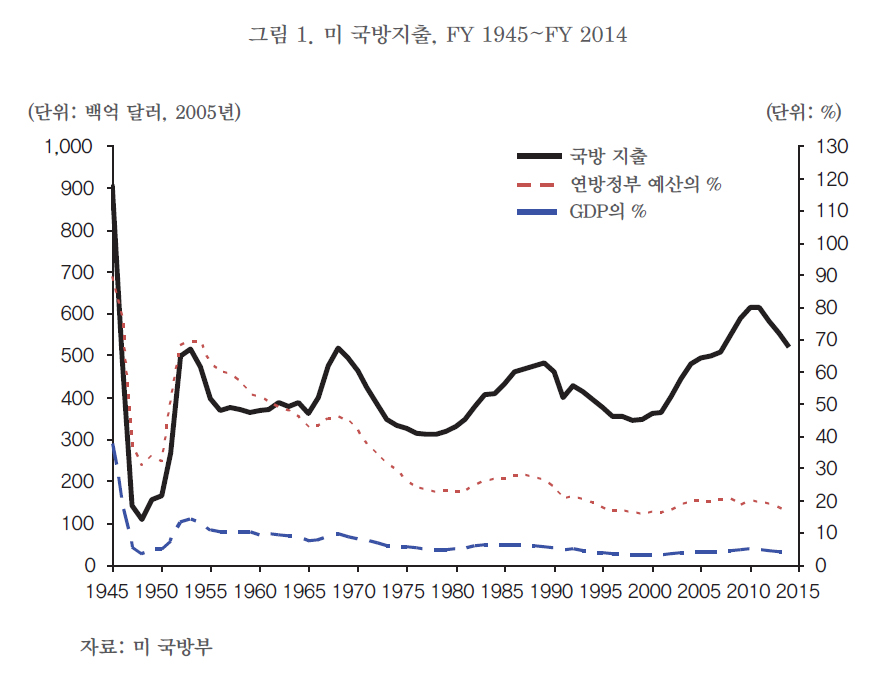
미 국방 지출의 규모와 성향을 파악하기 위해서는 역사적인 배경을 이해해야 한다. 즉, 현재 진행되고 있는 국방지출삭감은 제2차 세계대전 이후로 다섯 번째 이며, BCA가 10년간 완전히 적용되는 경우 국방 예산 변화의 영향은 적지 않을 것이다 (그림 1 참조). BCA가 실행될 경우 국방예산은 10년 안에 4천8백70억 달러 감소한다. 이 액수를 같은 기간 동안 시행하는 5천억 달러의 추가 자동지출삭감과 오바마 행정부가 부과로 지시한 1천5백억 달러의 삭감과 함께 계산하면 미 국방부의 10년간 진행되는 총 지출삭감은 약 1조 달러라고 볼 수 있을 것이다.2 물론 전문가에 따라 국방비 삭감 계산이 조금씩 다를 수 있다. 예를 들어 브루킹스 연구소의 마이클 오한론은 BCA의 부과 감소를 4천8백70억달러보다 다소 낮은 3천5백억 달러로 예측하는가 하면, AEI 연구소의 매켄지 이글렌은 BCA가 적용되기도 전에 국방비의 3년 동안 진행된 지출 감소가 1조 달러를 넘어섰다고 주장하고 있다.3 액수에 차이가 있지만 한 가지 공통점은 모두 국방비의 삭감이 예측 보다 과하다고 주장하는 것이다. 많은 분석가들은 BCA가 완전히 적용되기도 전에 미 국회에서 양당의 협상을 기대하거나, 빠른 경기 회복으로 인해 미국 정부의 예산 문제가 해결되길 바라고 있지만 적어도 2014년도에는 미 국방비가 5백2십억 달러 줄어들 것은 분명하다.
만약에 국방예산이 이같이 줄어든다면 미국의 국방 전략은 어떻게 바뀔 것이고 이러한 변화는 동아시아에 어떤 영향을 미칠 것인가? 국방지출삭감이 어떻게 시행될 것인지에 대해서는 아직 확실하지 않지만 지난 7월 말 국방부는 이 문제를 다루는 연구 결과를 발표한 바 있다. 국방부가 발표한 내부 보고서(Strategic Management and Management Review, SCMR)는 미국의 국방 전략을 방어능력(즉, 육/해/공군의 병력 수), 방위력(무기 시스템과 방어 기술 현대화), 준비태세로 나누어 해석한다.4 미 국방부는 이 세가지 요소 중 국방전략의 초점을 방어능력과 방위력에 맞추었다. 만약 방어능력을 강조하는 전략을 선택한다면 미군의 병력 수는 지금 현재 상태로 유지되지만 기술이나 무기 시스템은 다른 나라들에 비해 뒤질 가능성이 크고 덜 효과적 일 것이다. 방위력을 강조하는 전략을 선택한다면 미군은 차세대 무기 시스템을 개발 할 수 있으나 지난 이라크-아프가니스탄과 같은 이중전선 전쟁을 시행하기엔 힘들 것이다. 이 두 가지 방안 중 국방부는 어떠한 선택을 하게 될지 두고 봐야 하겠지만 워싱턴에 국방전략 전문가 대부분은방위력을 강조하는 전략을 선호하는 듯하다. 예를 들어 국방부의 발표와 함께 미국에 4개의 국방전략 전문 싱크탱크들이 발표한 결과를 살펴보면 국방 부가 새로운 무기 기술에 대한 투자를 강조할 뿐만 아니라, 국방부의 민간직을 줄이는 선택을 선호하고 있다(표1 참조)5.
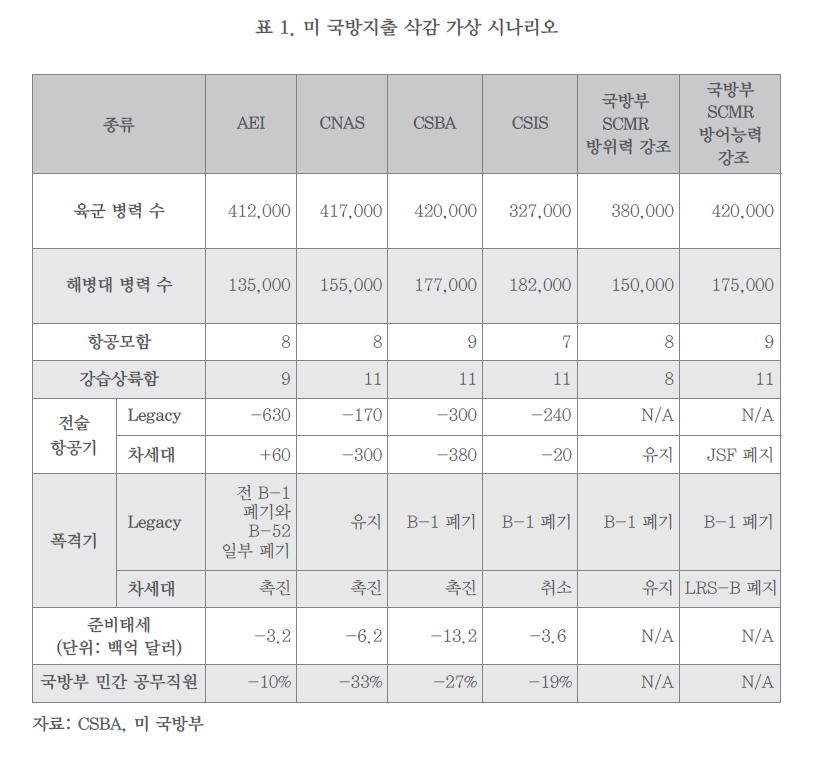
전략은 어디로…?
위에 거론되고 있는 내용의 문제점은 미국의 국방정책이 전략보다 예산에 의해 진행되고 있다는 것이다. 한반도에 관련된 국방부의 공식적인 입장은“국방비 삭감이 아/태 중시 전략과 한미동맹에는 전혀 영향이 없다”이지만 예산 문제와 관련된 현실 속에서 이 자세를 유지 할 수 있을지는 확인하고 넘어갈 필요가 있다.6 지난 2012년 미국의 선임 싱크탱크인 CSIS가 출간한 한 보고서에 따르면 미국의 예산이 급격히 줄어듦으로써 미국의방어 자세가 바뀐다면 주한미군의 인원이 14,000명에서 18,000명 사이로 줄어들 수 있고, 일본 오키나와에서 해병대 9,000명의 철수와 함께 한국과 일본에 있는 네 개의 F-16 공군중대가 붕괴 될 수도 있다고 발표한 사례가 있다.7
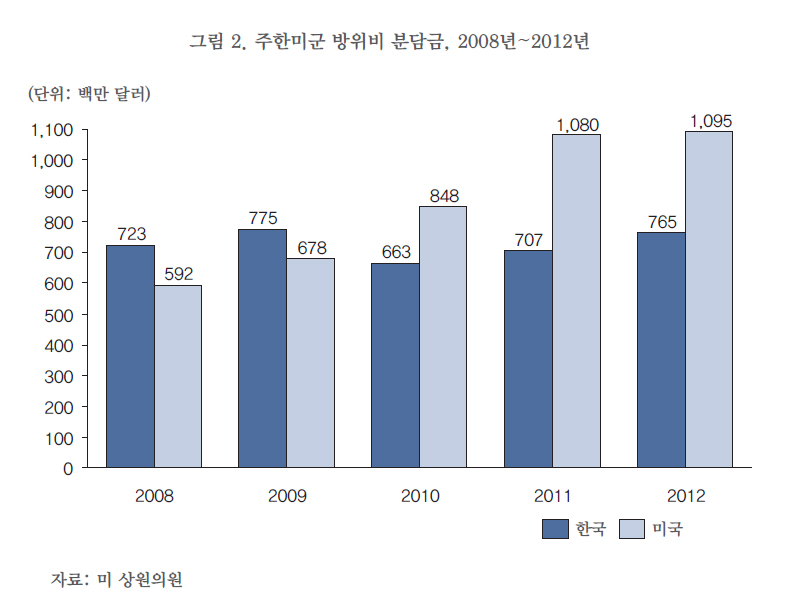
그렇다면 주한미군의 철수가 임박한 것인가? 만약 주한미군의 방어태세가 바뀌어야 한다면 감축보단 늘리는 것이 올바른 선택일 것이다.8 하지만 예산 문제가 해결되지 않고 있는 상황에서 국방부가 아/태 지역의 국방예산을 줄여야 한다면 주한미군만큼은 삭감 대상이 되어선 안 될만한 이유를 3가지로 정리해 볼 수 있다. 첫째, 주한미군의 예산이 낮지는 않지만, 미국의 총 국방예산에 비해 큰 영향을 미치진 않기 때문이다. 현재 주한 미군의 국방예산 금액은 11억 달러이다. 해외 주둔 (아프가니스탄 제외) 총 액수인 100억 달러에 비해 아주 작은 일부에 해당 된다.9 만약 아/태 지역에서 미군의 지원을 축소해야 한다면 일본과 같은 나라의 주둔 병력 재배치가 예산감축에 더 효율적일 것이다. 둘째, 북한의 도발이 최근 들어 더욱 강하고 담대해 졌다는 점을 배제할 수 없다. 물론 북한의 무기나 국방력은 한국의 최첨단 방어 기술에 비해 뒤지고 있지만, 역사적인 면에서 볼 때 기술의 우수성이 북한의 방위능력을 판단하는 기준이 되지 못한다는 것을알 수 있다. 예를 들어, 2010년 천안함 침몰사건은 북한해군이 기술적으로 뛰어난 남한에 맞서 대응 할 수 있는지를 보여 주는 중요한 예이다. 무엇보다 북한은 최신 재래식 무기보다 사이버 테러와 핵무기 개발, 그리고 중단거리 미사일을 보유하고 있다는 점도 고려해야 할 것이다(표 2와 그림 3 참조)10.
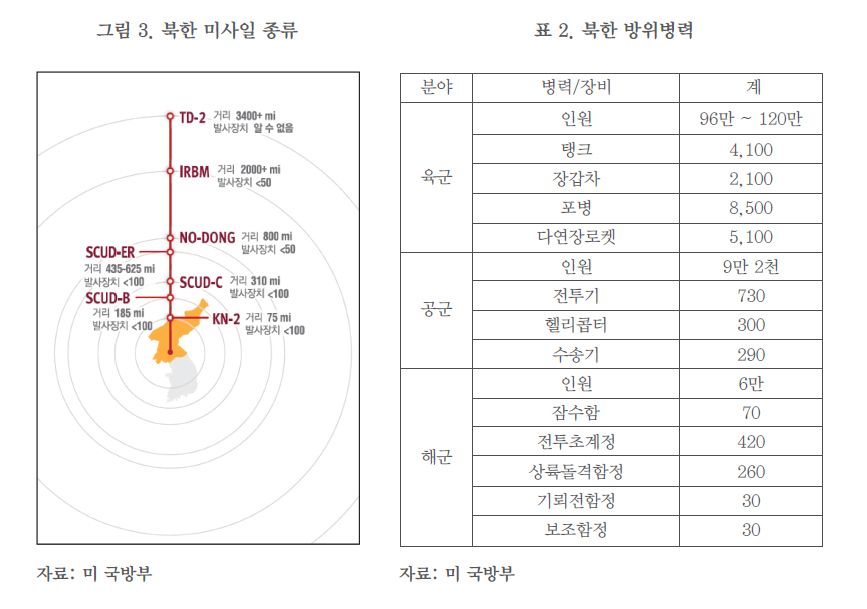
마지막으로, 한미 동맹의 관점에서 볼 때 주한미군의 중요성은 더욱 확고하다. 최근 아산 정책연구원에서 실시한 설문 조사에 의하면 여론의 압도적인 수는 주한미군의 장/단기간 존재를 지지하고 다수(48%)는 통일 이후에도 지속적으로 주한미군의 존재를 지지하고 있다(그림 4 참조). 적지 않은 다수(50%)가 주한미군을 사회적이나 역사적인 문제라고 생각하기도 하지만 그중 대다수 ( >80%)는 주한미군의 필요성을 인정한다. 이 이유는 대다수( >60%)가 주한미군이 한반도의 평화와 안보에 기여 한다고 생각하기 때문이다(그림 5 참조)
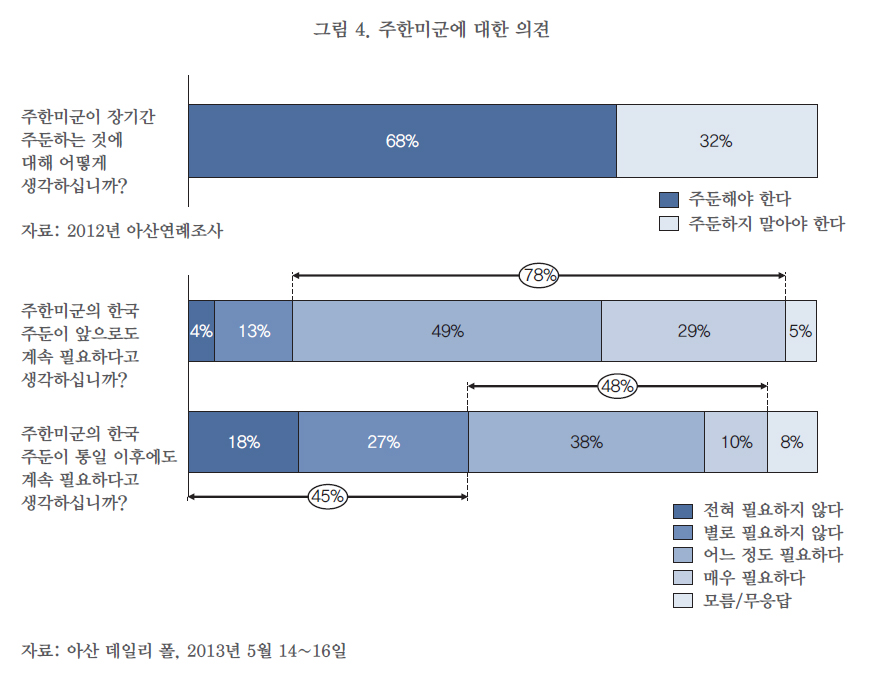
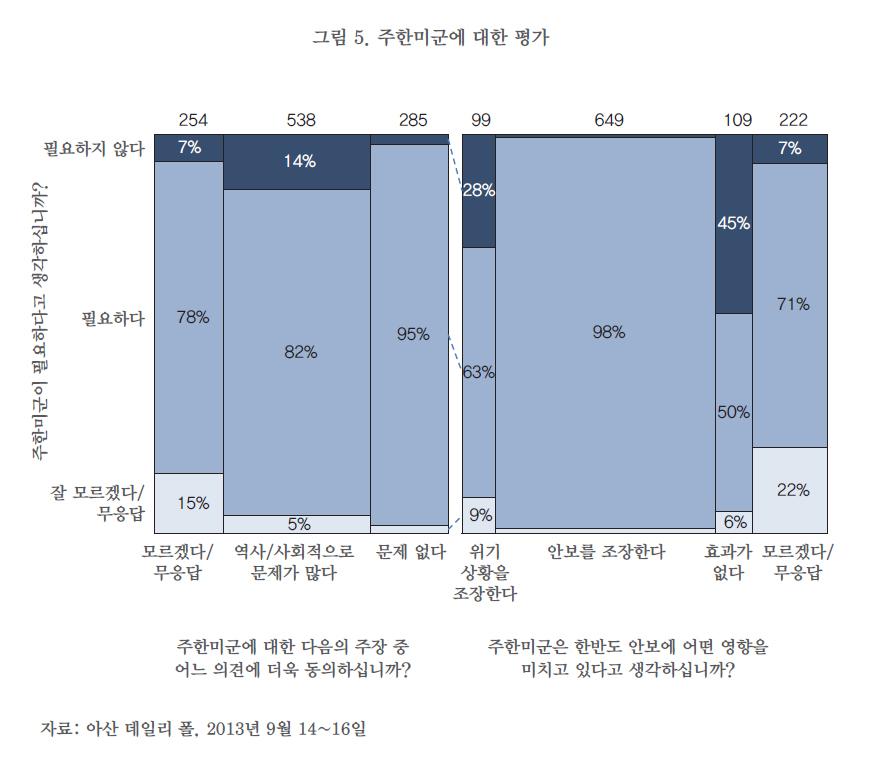
대책 방안
정책적인 면에서 볼 때 주한미군의 감축이나 철수는 그리 현명한 선택은 아니다. 하지만 위에서 말한 바와 같이 미국의 국방예산삭감은 계산된 선택이 아니다.11 이러한 현실 속에서 한국 정부는 미국의 국방정책이 바뀔 것을 기다릴 것만이 아니라 국방예산삭감과 워싱턴의 전략적 우선순위 변경을 대비하여 대책 방안을 생각할 시점에 도달했다는 것이다. 그렇다면 구체적으로 현 정부가 할 수 있는 일은 무엇일까?
첫째, 박근혜 정부는 기존의 국방개혁 307계획(DR307)을 재검토할 필요가 있다. 몇몇 전문가들은 주한미군이 30% 감소하여도 북한의 선제공격을 저지하는 데 어려움이 없을 것 이라고 주장하고 있지만12 현재 주한미군의 수준으로 연평도나 천안함 사건, 또는 3차 핵실험 등 연속으로 진행되고 있는 미사일 실험 같은 북한의 도발을 중단시키지 못했다는 점을 무시할 수 없다. 307계획은 전 노무현 정권의 국방개혁 2020에 비해 높은 평가를 받았으나 미국의 국방예산삭감이나 국방정책 변화에 초점을 맞춘 방안은 아니다.13 그러므로 이러한 현실 속에서 현 정부는 307계획에서 주도하는 전력증강이나 국방인력의 규모를 재검토할 필요가 있다.
다른 방안으로 현 정부가 빠른 결과를 원한다면 먼저 한국의 국방예산을 높여야 할 것이다. 한국의 국방예산은 1998년 이후로 GDP의 3%라는 장벽을 뛰어넘지 못했다. GDP의 3%는 국방개혁 2020이 목표로 삼았던 국방지출 수준이다. 물론 한국의 경제는 계속하여 성장하고 있어서 국방예산은 시간에 따라 증가해 왔지만 경제가 활성된 만큼 한국의 안보도 강화 되지 못했다는 것이다. 지난 15년간 한국의 평균 국방예산은 GDP의 2.6%였다.14 현 상황을 감안할 때 더욱 합리적인 지출 수준은 GDP의 3~4% 범위라고 볼 수 있다. 국방예산 다음으로 방위비 분담 특별협정(Special Measures Agreement, SMA)에서 한국이 부담하는 방위비를 늘리는 방법도 생각해볼 만 하다. 예를 들어 방위비 분담 계산에서 물가상승률이 4%를 초과하지 않도록 계산하는 방식은 북한과 같은 나라를 염두에 두었을 때 이해하기 힘든 조건이다. 북한의 방어력이 어떻게 바뀔지 모르는 상황에 주한미군의 유연성을 제한하는 것은 전략적으로 의문스럽지 않을 수 없다. 즉 한국의 입장에서는 한미 방위비 특별협정을 예산에 맞출 것인지 국방전략에 맞출 것인지 고민 해야 할 만한 문제이기도 하며, 만약 전략적인 이유로 한국의 분담금 비율을 높인다면 같은 맥락으로 전시 작전통제권전환을 미루는 방안도 생각해볼 만한 조건이 될 수 있다. 박근혜 정부는 다른 나라들과의 상호 관계를 유지/강화하는 방법을 택할 수도 있다. 한국의 외교관계에서 무역을 빼놓기는 힘든 상황이다. 중-일자유무역 협상이나 환태평양경제 동반자협력체제(Trans-Pacific Partnership, TPP)는 무역을 통해 국가이익을 상승시키므로 모든 참여국이 전쟁보다는 평화를 유지하는 인센티브를 추구한다는 것이다.15 주의해야 할 점은 이런 무역체제가 실질적으로 모든 참여국의 절대 이득(absolute gain)을 상승시켜야 한다는 것이다.
무역 외에도 정부는 아시아태평양의 새로운 안보 모델이나 협력 체제를 구성하는 역할을 생각해 볼 수 있다. 동아시아정상회의(East Asia Summit, EAS) 아세안국방장관회의 플러스(ASEAN Defense Ministers’ Meeting Plus, ADMM+) 또는 ASEAN 포럼(ASEAN Regional Forum, ARF) 같은 기존의 지역협력협정에서 한국이 더욱 적극적인 역할을 함으로써 새로운 지역 안보체제의 의제설정을 제기할 수 있다는 것이다. 이 셋 중 중국과 미국의 참여에 힘입어 ADMM+가 아시아의 새로운 안보 체제를 추구할 수 있을 만한 모델로 부상하고 있다16. 물론 태평양 안보 프레임워크를 개최하는 데 여러 장애물이 있겠지만 한반도의 불안정은 모든 지역 국가들의 숙제이기도 하다. 북한 문제가 국제적으로 영향을 줄 수 있는 사안인 만큼 한국이 지역안보체제에 리더로 앞장설 수 있는 좋은 기회이기도 하다는 것이다.
결론
미국 경제는 회복되고 있지만, 워싱턴의 예산위기는 쉽게 해결되지 않을 것이다. 지금 이 상황이 향후 10년간 변하지 않는다면 10년 후 한국은 선택의 여지가 없는 상황에 놓일 것이고 보다 힘든 선택을 해야 할지 모른다. 다행인 것은 아직은 늦지 않았다는 점이다. 현 정부가 어려운 미래를 대비하여 올바른 선택을 할 수 있는 기회를 가지고 있다는 것이다. 지금 이 상황에서 한국은 어느 선택을 할 것인가?
The views expressed herein do not necessarily reflect the views of the Asan Institute for Policy Studies.
-
1
Leon Panetta, “Sequestration’s Self-Inflicted Wounds,” The Washington Post, September 2, 2013; Weisgerber, Marcus, “Sequestration Could Chop $33B from DoD Investments,” DefenseNews, July 10, 2013.
-
2
“Statement on Strategic Choices and Management Review,” as delivered by Secretary of Defense Chuck Hagel, July 31, 2013.
-
3
Robert Barro and Veronique de Rugy, Defense Spending and the Economy (Arlington, VA: George Mason University Mercatus Center, 2013); Peter W. Singer, “Separating Sequestration Facts from Fiction: Defense Sequestration and What It Would Do for American Military Power, Asia, and the Flashpoint of Korea,” Time Magazine, September 23, 2012.
-
4
Note that this estimate is based on a Statement on Strategic Choices and Management Review by the Secretary of Defense.
-
5
“Statement on Strategic Choices and Management Review,” Chuck Hagel; Claudette Roulo, “‘Painful’ Review Looked at Every Corner of DoD, Winnefeld Says.” American Forces Press Service, July 31, 2013.
-
6
Michael O’Hanlon, Healing the Wounded Giant: Maintaining Military Preeminence while Cutting the Defense Budget (Washington, DC: Brookings Institution Press, 2013).
-
7
Mackenzie Eaglen, “The Pentagon’s illusion of choice: Hagel’s 2 options are really 1,” American Enterprise Institute, August 1, 2013, http://www.aei.org/article/foreign-and-defense-policy/defense/the-pentagons-illusion- of-choice-hagels-2-options-are-really-1/.
-
8
Department of Defense, Sustaining U.S. Global Leadership: Priorities for 21st Century Defense, January 2012.
-
9
“Statement on Strategic Choices and Management Review,” Chuck Hagel.
-
10
Strategic Choices Exercise Outbrief, CSBA, May 29, 2013, http://www.csbaonline.org/publications/2013/05/ strategic-choices-exercise-outbrief/; Analysis of the DoD SCMR Options, CSBA, August 1, 2013, http://www.cs- baonline.org/2013/08/01/analysis-of-the-dod-scmr-options/.
-
11
Defense Department Background Briefing on the Strategic Choices and Management Review in the Pentagon Briefing Room, US Department of Defense, July 31, 2013.
-
12
Michael J. Lostumbo et al., Overseas Basing of US Military Forces: An Assessment of Relative Costs and Strategic Benefits (Santa Monica, CA: RAND Corporation, 2013); Report on Conventional and Nuclear Forces in the Western Pacific Region, letter to the Chairman of the Committee on Armed Forces, July 26, 2013.
-
13
Center for Strategic & International Studies, US Force Posture Strategy in the Asia Pacific Region: An Independent Assessment (August 2012). It is important to note that the DoD’s current official position is that South Korea will not be impacted by the sequester. As noted by the Deputy Secretary of Defense Ash Carter during a public statement in June 2013—“[the DoD] exempted a number of other critical functions from sequester – for example, nuclear deterrence, our ability to respond immediately to crises. . . on the Korean Peninsula, for example, if that were to become necessary….” See: “Korea immune from U.S. military budget cuts: Pentagon official,” Korean Herald, June 13, 2013, http://www.koreaherald.com/view.php?ud=20130613000144.
-
14
US Senate Committee on Armed Services, Inquiry into US Costs and Allied Contributions to Support the US Military Presence Overseas, April 15, 2013. This fìgure does not include more than US$2 billion in US military personnel costs as well as South Korea’s contributions for offsetting US costs.
-
15
There are two plans in place to consolidate US forces on the Korean Peninsula into Camp Humphreys (40 miles south of Seoul) and Daegu. The Land Partnership Plan (LPP), which is projected to cost about US$3.2 billion, involves repositioning US forces from areas north of Seoul to Camp Humphreys and Daegu. The Yongsan Relocation Plan (YRP) with a heftier price tag of US$7 billion calls for moving US forces from the current base in Yongsan to Camp Humphreys.
-
16
For a more thorough discussion on why the United States should increase its presence in the Asia-Pacifìc, see: Bruce Klingner and Dean Cheng, “America’s Security Commitment to Asia Needs More Forces.” Background- er, no. 2715, August 7, 2012; Dean Cheng and Bruce Klingner, “Defense Budget Cuts Will Devastate America’s Commitment to the Asia-Pacifìc,” Backgrounder, no. 2629, December 6, 2011.
-
17
North Korea has become more daring and confìdent in its provocations against the South. Two most notable examples include the sinking of the Pohang-Class corvette named Cheonan near the Northern Limit Line on March 26, 2010 and the shelling of Yeonpyeong Island in November of that same year. In 2013, North Korea claims to have conducted a third nuclear test, which recorded the largest seismic activity to date. Finally, the successful launch of Kwangmyongsong in December 2012 marks an important turning point which suggests that North Korea is one step closer to developing a long-range payload capability. Finally, the latest report of possible activity at the Yongbyon facility suggests that North Korea has resumed production of plutonium.
-
18
Office of the Secretary of Defense, Military and Security Developments Involving the Democratic People’s Republic of Korea, Annual Report to Congress, February 15, 2013.
-
19
From South Korea’s viewpoint, North Korea is a clear and present threat given its forward deployed arsenal of fìeld artillery and multiple rocket launchers (MRLs). Even though only a fraction of these may have the range to reach Seoul, most independent experts confìrm that North Korea possesses the capability to deliver as many as 20,000 shells an hour to downtown Seoul. See Chad O’Carroll, “North Korea’s Conventional Weapons Threat,” Korea Economic Institute, February 5, 2013, http://blog.keia.org/2013/02/north-koreas-convention- al-weapons-threat/.
-
20
Brendan Nyhan, “The Green Lantern Theory of Sequestration,” Columbia Journalism Review, February 27, 2013; Brendan Greeley, “Lessons of Avoidance from Gramm’s ‘Pac-Man’ Budget Sequestration,” Bloomberg News, March 29, 2013; Laura Matthews, “Defense Spending Cuts 2013: Should Obama Worry Sequester Effects Could Shape His Legacy?” International Business Times, February 21, 2013.
-
21
Peter Singer, “Separating Sequestration Facts from Fiction.”
-
22
Bruce W. Bennett, “The Korean Defense Reform 307 Plan” Issue Brief, no. 8, The Asan Institute for Policy Studies, 2011; Bruce. Klingner, “South Korea: Taking the Right Steps Toward Defense Reform” Backgrounder, no. 2618, Heritage Foundation, October 19, 2011; Rhee Sang-Woo, “From Defense to Deterrence: The Core of Defense Reform Plan 307” Korea Chair Platform, CSIS, September 7, 2011.
-
23
SIPRI Military Expenditure Database.
-
24
Current schedule on the transfer of Operational Control (OPCON) should also be reconsidered with this principle in mind. As some critics have noted already, the possible dismantling of the Combined Forces Com- mand can send the wrong signal to North Korea that there may be a sizable cut in the number of US troops deployed to South Korea in case of an emergency (See 2006 SAIS US-Korea Yearbook).
-
25
The logic, of course, dates back as far as Baron de Montesquieu, who noted in 1750 that “peace is the natural effect of trade.” See also Solomon W. Polacheck, “Conflict and Trade,” Journal of Conflict Resolution 24 (1980): 55-78; Solomon. W. Polache and Carlos Seiglie, “Trade, Peace and Democracy: An Analysis of Dyadic Dispute,” IZA Discussion Paper Series, no. 2170 (2006); Erik Gartzke, “Chapter 2: Economic Freedom and Peace,” in Economic Freedom of the World: 2005 Annual Report, ed. J. Gwartney, R. Lawson, and E. Gartzke (Toronto: The Fraser Institute, 2005).
-
26
David W. Mabon, “Elusive Agreements: The Pacifìc Pact Proposals of 1949-1951,” Pacific Historical Review 57, no. 2 (1988): 147-177; Charles M. Dobbs. “The pact that never was: The pacifìc pact of 1949.” Journal of Northeast Asian Studies, no. 4 (1984): 29-42.
-
27
“The US Approach to Regional Security,” Statement by US Secretary of Defense Chuck Hagel at the Shangri-La Dialogue, 2013; Bonnie S. Glaser, “American Reassurance of Rebalance Encourages Cooperation and Progress at ADMM+” cogitASIA, Septmber 5, 2013, http://cogitasia.com/american-reassurance-of-rebalance-encour- ages-cooperation-progress-at-admm/; Brian Harding, “Don’t underestimate the ADMM+” PacNet #65R, CSIS, August 19, 2013, http://csis.org/publication/pacnet-65r-dont-underestimate-admm; Vibhanshu Shekhar, “ADMM+: Another Case of ‘Pretentious Diplomacy’?” IPCS, October 29, 2010, http://www.ipcs.org/article/china/admm-another-case-of-pretentious-diplomacy-3268.html; Chu Shulong, “The East Asia Summit: Looking for an Identity,” Brookings Northeast Asia Commentary, no. 6, February 2007.
-
28
Choi Young Jong, “South Korea’s Regional Strategy and Middle Power Activism,” The Journal of East Asian Affairs 23, no. 1 (2009): 47-67.

J. James Kim
Senior Research Fellow
J. James Kim 박사는 아산정책연구원의 지역연구센터 선임연구위원으로 재직 중이며 Columbia University 국제대학원 겸임 강사이다. Cornell University에서 노사관계 학사와 석사학위를 마치고 Columbia University에서 정치학 박사학위를 취득하였다. California State Polytechnic University, Pomona의 조교수(2008-12)와 랜드연구소의 Summer 연구원(2003-2004) 등을 역임한 바 있다. 주요연구 분야는 비교민주주의 제도, 무역, 방법론, 공공정책 등이다.



